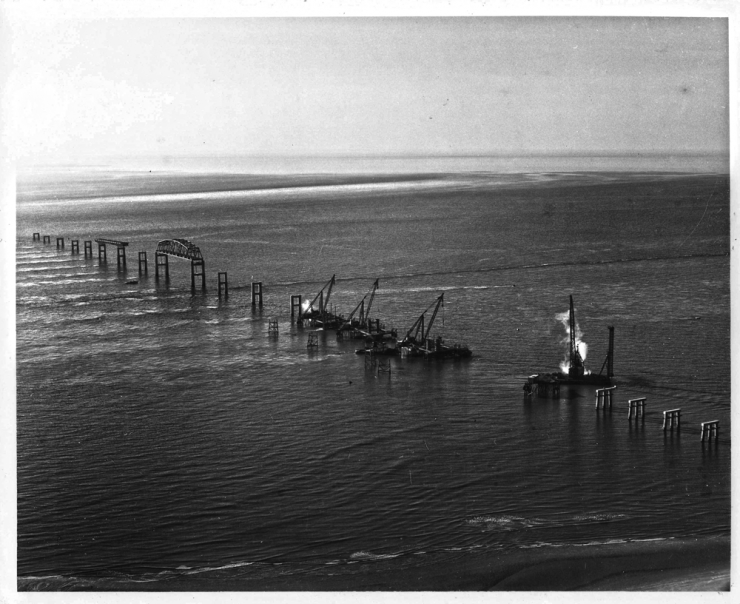The Chesapeake Bay Bridge-Tunnel (CBBT) spans 23 miles at the mouth of the Chesapeake Bay, connecting Northampton County on the Delmarva Peninsula with Virginia Beach. From shore to shore, the structure measures 17.6 miles. It includes 12 miles of low-level trestle, two one-mile tunnels, two bridges, nearly two miles of causeway, four man-made islands, and five and a half miles of approach road, totaling 23 miles. The complex cuts 95 miles off the journey from Virginia Beach to points north of Wilmington, DE, making it a feat of civil engineering.
Following its opening on April 15, 1964, the CBBT was selected as “One of the Seven Engineering Wonders of the Modern World.” To date, over 116 million commercial and passenger vehicles have made the crossing. From the early 1930s to 1954, Virginia Ferry Corporation, a privately owned public service company, managed scheduled ferry service between Virginia’s Eastern Shore and the Norfolk/Virginia Beach area. In 1954, the Chesapeake Bay Ferry District was established by the Virginia General Assembly, along with the Chesapeake Bay Ferry Commission as the governing body. Not long after, however, the General Assembly began exploring the possibility of a fixed crossing, as the number of passengers traveling by ferry continued to increase year after year. Results of the study indicated that a fixed crossing was in fact feasible, and a series of bridges and tunnels was the plan put forth.
In the summer of 1960, the Chesapeake Bay Ferry Commission sold $200 million in revenue bonds to private investors, and the proceeds were used to finance the building of the bridge-tunnel. Additionally, monies collected by future tolls were pledged to pay the principal and interest on the bonds. No state, local, or federal tax money was used for construction costs.
Construction officially began in October 1960 and the CBBT complex was completed 42 months later. The chosen path for the bridge-tunnel crossed two of the busiest shipping channels on the coast – one into Norfolk, the other into Baltimore. It was therefore decided that there would be two tunnels, each about a mile long, so as not to interfere with the shipping channels.
A second concession was made near Virginia’s Eastern shore at Fisherman Island – a steel bridge, higher than the rest of the concrete trestle, would cross most of the Bay so as to give clearance to fishing vessels. Concrete cylinders, measuring four and a half feet across, were driven as deep as 125 feet into the soil bed and four man-made islands were constructed, each wider than a football field and nearly four times as long.
The 42-month construction process was undertaken, at times, in the harshest of conditions. Everything from hurricanes, nor’easters, and the day-to-day buffeting of wind and waves at the mouth of the Chesapeake Bay made for a difficult construction site. During the Ash Wednesday storm of 1962, much of the partially completed work and a custom-built pile driver, worth $1.5 million, were destroyed. Seven workers lost their lives at various points in the process, and there were countless more injuries. Regardless, most of the men returned month after month, for the decent pay and the excitement that came with working on the Bay.
The CBBT officially opened to traffic on April 15, 1964, whereby ferry service was completely discontinued. In April 1999, a parallel crossing was completed which expanded the two-lane facility into four lanes and included expansion of toll plazas, trestles, bridges, and roadways, and maintenance and repair on the original span. In May 2013, a plan was approved to expand tunnel capacities, but as of yet the CBBT continues to use the original two lane tunnels. To learn more about the future of the bridge-tunnel, click to cbbt.com